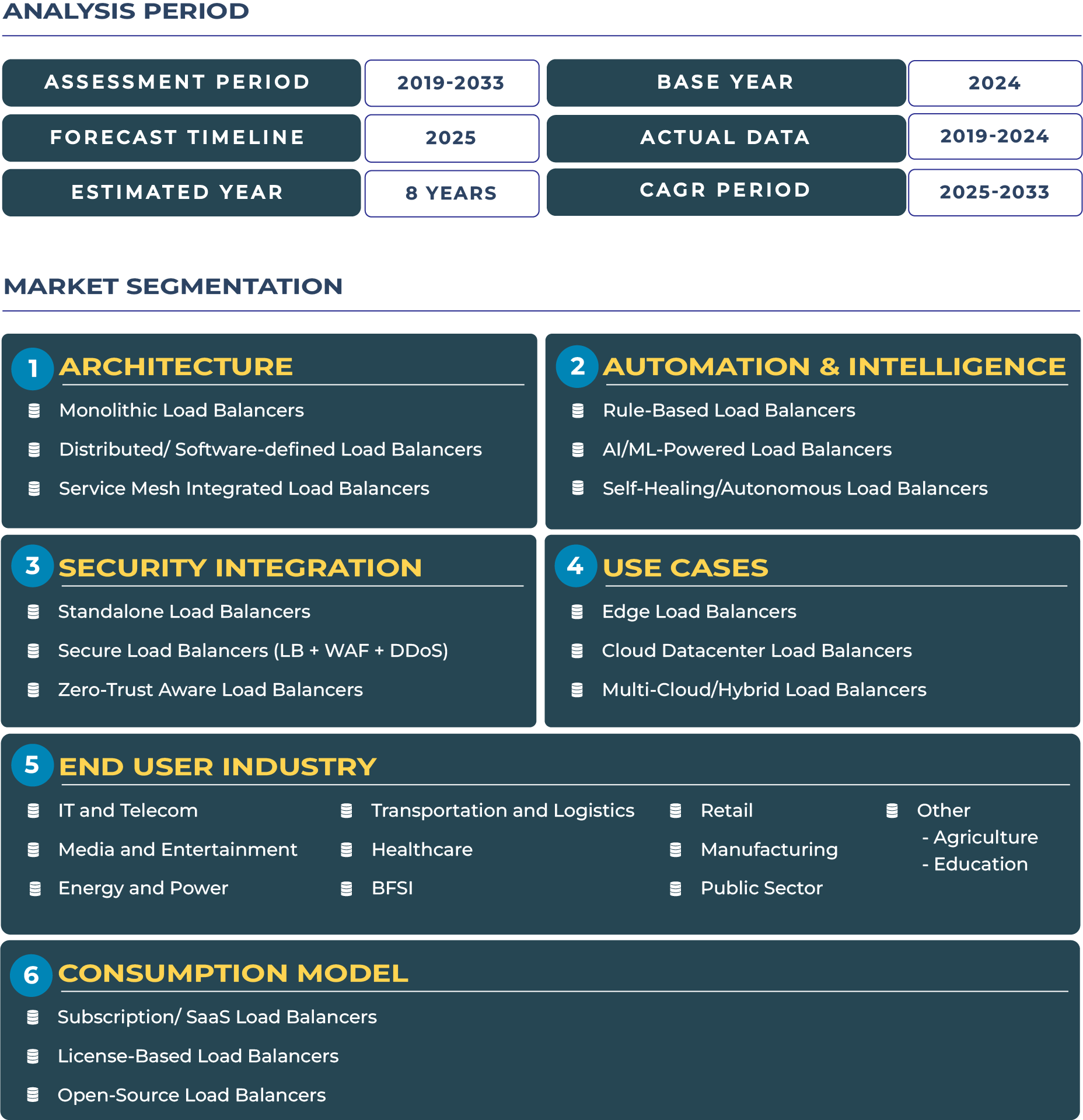Report Format:
![]()
![]() |
Pages: 110+
|
Pages: 110+
Small Market with Strong State Push: Outlook of Kuwait Cloud Load Balancers Market
Kuwait, though one of the smaller economies in the Gulf, is rapidly emerging as an ambitious market for cloud-first transformation. The government’s emphasis on digitization—particularly in finance, healthcare, and oil & gas—is laying the foundation for resilient cloud architectures. Within this modernization agenda, cloud load balancers are gaining traction as mission-critical tools that ensure application performance, resilience, and compliance across distributed cloud environments. The Kuwait cloud load balancers market is projected to expand from USD 10.6 million in 2025 to USD 30.0 million by 2033, registering a robust CAGR of 13.8%. This growth trajectory is supported by the public sector’s strong influence, financial institutions’ cloud adoption strategies, and modernization efforts by national telecom operators. Despite regional geopolitical uncertainty, Kuwait’s long-term strategy to digitize government services and empower regulated sectors ensures steady demand for distributed and service-mesh integrated load balancing solutions.
Growth Catalysts and Constraints Defining Kuwait’s Cloud Load Balancers Industry
The expansion of Kuwait cloud load balancers industry is closely tied to its state-driven digital programs. Government digitization across finance and oil & gas sectors is creating large-scale requirements for resilient cloud-native architectures. The Communication and Information Technology Regulatory Authority (CITRA) is introducing cloud-friendly regulations that enhance compliance while encouraging adoption. Meanwhile, telecommunication modernization programs led by operators like Ooredoo Kuwait and Zain are enabling edge services and hybrid deployments, accelerating the role of distributed load balancers in low-latency applications.
However, certain restraints moderate this growth. Kuwait remains a small market in scale, limiting the size of tenders and revenue opportunities. Public-sector procurements are often tied to lengthy approval and tendering cycles, slowing deployment timelines. Moreover, the country faces shortages of specialized digital skills, forcing reliance on foreign expertise for advanced service-mesh architectures. Together, these factors create a competitive but challenging environment where vendors must balance long-term partnerships with agile delivery models.
Emerging Market Trends and Expanding Opportunities in Kuwait’s Cloud Load Balancers Landscape
Several emerging trends are reshaping the Kuwait cloud load balancers landscape. Increasing adoption of sovereign-lite cloud deployments is enabling public agencies to balance compliance with modernization. Hybrid cloud adoption in regulated industries such as banking and insurance is becoming a norm, creating demand for software-defined load balancers that seamlessly manage workloads across private and public infrastructures. The growing reliance on managed cloud services in Kuwait City and other urban hubs is also expanding opportunities for vendors that integrate load balancing as part of bundled offerings.
In terms of opportunities, the oil & gas vertical offers significant potential for tailored load balancing solutions, ensuring resilience for mission-critical applications in energy operations. Large public-sector modernization projects continue to be high-value segments, with strategic focus on e-government portals, digital health systems, and education services. Additionally, telco-channel bundles, where telecom operators integrate load balancing within their broader managed services portfolio, provide a ready route-to-market and trusted ecosystem for vendors entering Kuwait’s digital economy.
Competitive Landscape: Strategies of Local and Global Players in Kuwait’s Cloud Load Balancers Sector
The competitive landscape in Kuwait’s cloud load balancers market is characterized by collaboration between global technology providers and regional telecom operators. International players like AWS, Microsoft Azure, and F5 Networks are increasingly engaging with local partners to deliver sovereign-compliant solutions. On the local side, leading operators such as Ooredoo Kuwait and Zain are aligning their offerings with public-sector modernization programs, embedding load balancing within enterprise and government solutions.
Strategically, the strongest momentum lies in targeting oil & gas and public sector clients via telecom and system integrator channels, as these industries are compliance-heavy and offer premium reference deals. In 2024, new managed cloud bundles were announced by Ooredoo Kuwait to support enterprise-grade application hosting with embedded traffic distribution, highlighting the growing importance of distributed and software-defined load balancing. Vendors that align with Kuwait’s regulatory environment while offering service-mesh readiness are expected to gain a competitive edge as the market advances toward 2033.







